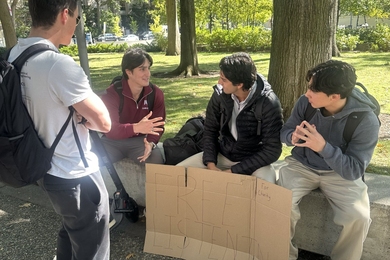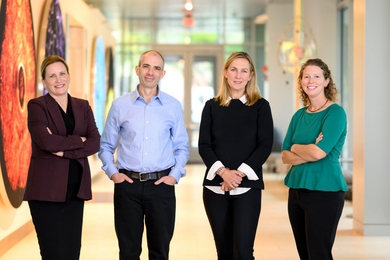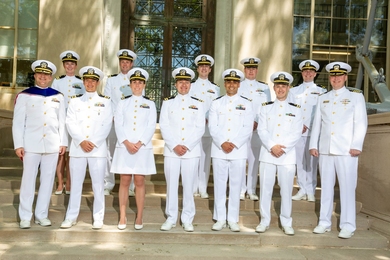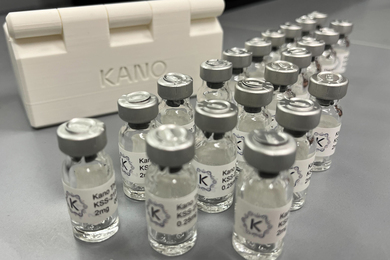Daniel Kleppner, the Lester Wolfe Professor Emeritus of Physics at MIT whose work in experimental atomic physics made an immense mark on the field, died on June 16 at the age of 92, in Palo Alto, California.
Kleppner’s varied research examined the interactions of atoms with static electric and magnetic fields and radiation. His work included creating precision measurements with hydrogen masers, including the co-invention of the hydrogen maser atomic clock; his research into the physics of Rydberg atoms and cavity quantum electrodynamics; and his pioneering work in Bose-Einstein condensation (BEC).
Kleppner, who retired in 2003 after 37 years at MIT, was a highly literate and articulate scientist whose exacting research and communication skills helped set the direction of modern atomic, molecular, and optical (AMO) physics. From 1987 to 2000, he was associate director of the MIT Research Laboratory of Electronics (RLE), and served as interim director in 2001. He also co-founded the MIT-Harvard Center for Ultracold Atoms (CUA) in 2000, where he was co-director until 2006.
While he was never awarded a Nobel Prize, Kleppner's impact on the field of atomic physics and quantum optics, and his generous mentorship, enabled the Nobel achievements of many others. His patient and exacting pursuit of discovery led to basic research insights that led to major achievements. His extensive research into the tiny atom provided the fundamental knowledge necessary for the huge: the eventual development of groundbreaking technologies such as the global positioning system (GPS), magnetic resonance imaging (MRI), and quantum computing.
“He was a leader in the department, and a leader in the American Physical Society,” says Wolfgang Ketterle, the John D. MacArthur Professor of Physics at MIT and a 2001 Nobel laureate. “He was a statesman of science. He was this eloquent person, this master of words who could express things in memorable ways, and at the same time he has this sense of humility.”
“Dan Kleppner was a giant in the area of AMO physics, and in science more broadly,” says John Doyle PhD ’91, Harvard Quantum Initiative co-director and Kleppner advisee who helped Kleppner create the Bose-Einstein condensate from atomic hydrogen. “Perhaps his most impactful legacy is leading a culture of respect and supportive community actions that all scientists in the area of AMO physics enjoy today. Not only did his science lay the path for current research directions, his kindness, erudition, and commitment to community — and community service — are now ever-expanding waves that guide AMO physics. He was a mentor and friend to me."
Kleppner’s daughter Sofie Kleppner notes: “People who worked on early lasers never imagined we would be scanning groceries at the checkout counter. When they developed the hydrogen maser, they were a bunch of nerdy people who really wanted to understand Einstein’s theory of relativity. This was the basis for GPS, this is how our flights run on time. Our dad was convinced that basic research today could lead to all sorts of valuable things down the road.”
Early life and career
Born in Manhattan on Dec. 16, 1932, Kleppner was the son of Vienna native and advertising agency founder Otto Kleppner, who wrote the best-selling book “Advertising Procedure.” His mother, Beatrice (Taub) Kleppner, grew up in New Jersey and was a graduate of Barnard College. She helped with Otto’s manuscripts. Daniel Kleppner was the second of three siblings; his brother, the late Adam Kleppner, was a professor of mathematics at the University of Maryland, and his sister, Susan Folkman, was a research psychologist at the University of California at Berkeley.
“As a teenager, I just liked building things,” Kleppner once said. “And that turned out to be very useful when I went on to become an experimental physicist. I had a crystal radio, so I could listen to the radio over earphones. And the thought that the signals were just coming out of the atmosphere, I remember thinking: totally remarkable. And actually, I still do. In fact, the idea of the electromagnetic field, although it’s very well understood in physics, always seems like a miracle to me.”
In high school, he was inspired by his physics teacher, Arthur Hussey, who allowed Kleppner to work all hours in the labs. “There was one time when the whole school was having a pep rally, and I wasn’t that interested in cheering football, so I stayed up and worked in the lab, and the high school principal noticed that I was in there and called me in and gave me a dressing down for lack of school spirit.”
He didn’t care. Hussey talked with Kleppner about quantum mechanics, and “that sort of put a bee in my bonnet on that,” and taught him a little calculus. “In those years, physics was extremely fashionable. These were the post-war years, and physicists were considered heroes for having brought the war to conclusion with the atom bomb, and … the development of radar.”
He knew by then that he was “destined to spend a life in physics,” he said in a video interview for InfiniteMIT. “It was an easy era to become delighted by physics, and I was.”
Studying physics at Williams College, he was drawn to Albert Einstein’s theory of general relativity. He built a programmable machine that he called a forerunner of cybernetics. Williams also instilled in him a lifelong love of literature, and he almost became an English major. However, he didn’t appreciate what he called the school fraternities’ “playboy” and “anti-intellectual” atmosphere, and worked to graduate quickly within three years, in 1953.
He deferred his acceptance to Harvard University with a Fulbright Fellowship to Cambridge University, where he met the young physicist Kenneth Smith, whose research was with atomic beam resonance. Smith introduced him to the book “Nuclear Moments,” by Harvard professor Norman Ramsey, and presented a proposal by Ramsey’s advisor I.I. Rabi, who invented a technique that could make an atomic clock so precise “that you could see the effect of gravity on time that Einstein predicted,” said Kleppner.
“I found that utterly astonishing,” Kleppner noted. “The thought that gravity affects time: I had a hard time just visualizing that.”
When Kleppner wandered Harvard’s halls in 1955, he was excited to see a door with Ramsey’s name on it. He was interested in Ramsey’s research on molecular beam magnetic resonance, atomic clocks, and precision measurements. “Fortunately, I came along at a time when he had an opening in his research group,” Kleppner recalled.
A new atomic clock
As Kleppner’s advisor, Ramsey encouraged him to create a new type of atomic clock, believing that cesium and ammonia masers, a technology of amplified microwaves, were not precise enough to measure the effect of gravity on time.
Kleppner’s thesis was on using the concepts behind an ammonia maser to advance toward a hydrogen maser, which uses the natural microwave frequency of hydrogen atoms and amplifies it through stimulated emission of radiation. Kleppner discovered that coherent cesium atoms can bounce from properly prepared surfaces without losing their coherence.
After his 1959 PhD, Kleppner stayed on at Harvard, becoming an assistant professor in 1962.
Kleppner’s research on hydrogen led to a method to keep hydrogen atoms locked in a glass container for study over a longer period of time. The result, featuring hydrogen atoms bouncing within a microwave cavity, is used to stabilize the frequency of a clock to a precision better than one microsecond in a year.
In 1960, he and Ramsey successfully created a new atomic clock whose significant stability could confirm the minute effects of gravity on time, as predicted by Einstein’s theory of general relativity.
The current generation of optical clocks “are good enough to see the gravitational red shift for a few centimeters in height, so that’s quite extraordinary, and it’s had an extraordinary result,” said Kleppner. “We got to rethink just what we mean by time.”
While the hydrogen maser did verify Einstein’s conjecture about time and gravity, it took more than a decade before being widely used, at first by radio astronomers. Today, atomic clocks such as the hydrogen maser are used in applications requiring high short-term stability, such as the synchronization of ground-based timing systems that track global positioning satellites, for timekeeping and communication by naval observatories to maintain a precise and stable time reference known as UTC (USNO); very long-baseline microwave interferometry (VLBI) that enables astronomers to achieve very high resolution and study distant radio sources, including black holes; and, indirectly, in magnetic resonance imaging.
“When we first set out to make these atomic clocks, our goals were about the least practical you can think of,” Kleppner said in an interview with the MIT Physics Department. “From being a rather abstract idea that you’d like to somehow witness, it becomes a very urgent thing for the conduct of human affairs.”
Ramsey went on to win the Nobel Prize in Physics in 1989 for his work on the separated oscillatory fields method and its application in the hydrogen maser and atomic clocks.
MIT, ultracold gases, and BEC advancements
Kleppner figured he wouldn’t get tenure at Harvard, “because no matter how generous and good-spirited Norman was, he casts a long shadow, and it was good for me to be at just the right distance. When I came to MIT, I had a pallet of experiments that I wanted to pursue, and some ideas about teaching that I wanted to pursue, and the transition was very simple.”
Kleppner joined the Institute in 1966, and his Harvard PhD student (and current MIT professor post-tenure) David Pritchard followed him, to work on scattering experiments: Kleppner worked with pulsed lasers, and Pritchard with continuous-wave (CW) lasers.
“He was young, he was verbal, and he seemed to have new ideas about what to do,” says Pritchard. “We foresaw how important lasers would become. For a long time, it was just Dan and myself. That was actually the era in which lasers took over. Dan and I started off, we both got into lasers, and he did Rydberg atoms, and I did collisions and spectroscopy of weakly bound molecules and two-photon spectroscopy.”
Kleppner led the tiny MIT Atomic Physics Group to eventually become the US News and World Report’s No. 1 nationally ranked atomic physics group in 2012. “Dan was the leader on this,” recalled Pritchard. “To start from non-tenure and build it into the number-one ranked department in your subfield, that’s a lifetime achievement.”
The group became what Pritchard called “the supergroup” of laser developers that included Charles Townes, who won the Nobel for his work; Ali Javan, who established a major laser research center at MIT; and Dolly Shibles. Pritchard joined the faculty in 1970, and Ketterle joined in 1990 as his postdoc. “We were pioneers, and the result was of course that our total group had a bigger impact.”
“He’s not just the father figure of the field, he is my scientific father,” says Pritchard. “When I’m writing something and it’s not going very well, I would sort of think to myself, ‘What would Dan say? What would he advise you?”
With MIT low-temperature physicist Tom Greytak ’63, PhD ’67, Kleppner developed two revolutionary techniques — magnetic trapping and evaporative cooling. When the scientific community combined these techniques with laser cooling, atomic physics went into a major new direction.
In 1995, a group of researchers, led by Kleppner's former students Eric Cornell PhD ’90 and Carl Weiman ’73, made a BEC using rubidium atoms, and Ketterle succeeded with sodium atoms. For this achievement, they received the 2001 Nobel Prize in Physics. Kleppner called BEC “the most exciting advance in atomic physics for decades.”
At a conference on BEC in 1996, Ketterle recalls Kleppner describing his own contributions: “'I feel like Moses, who showed his people the Holy Land, but he never reached it himself.' This was exactly what Dan did. He showed us the Holy Land of Bose-Einstein condensation. He showed us what is possible … He was the godfather of Bose-Einstein condensation.”
But he did reach the Holy Land. In 1998, when only a few groups had been able to create BECs, Kleppner and Greytak realized a hydrogen BEC. When he presented their work at the summer school in Varenna soon afterward, he received a long-lasting standing ovation — after 20 years of hard work, he had reached his goal.
“It is an irony that when Dan started this work, hydrogen was the only choice to reach the low temperatures for BEC,” says Ketterle. But in the end, it turned out that hydrogen has special properties that made it much harder to reach BEC than with other atoms.
Video: National Science and Technology Medals Foundation
Rydberg atoms
In 1976, Kleppner pioneered the field of Rydberg atoms, a highly excited atom that shares the simple properties that characterize hydrogen. Kleppner showed that these states could be excited by a tunable laser and easily detected with field ionization. He then mapped out their response in high electric and magnetic fields, which he used to provide new physical insights into the connections between quantum mechanics and classical chaos.
In 1989, his research into atomic energy levels, under conditions where the corresponding classical motion is chaotic, mapped out the positions of thousands of quantum levels as a function of laser frequency and applied field using high-resolution laser spectroscopy. His observations gave new physical insight into the implications of classical chaos on quantum systems.
“I see Dan as being the inventor of Rydberg atoms,” says Dan’s former student William Phillips PhD ’76, physicist at the Institute of Standards and Technology (NIST). “Of course, Rydberg atoms is something that nature gives you, but Dan was the one who really understood this was something that you could use to do really new and wonderful things.”
Such atoms have proved to be useful for studying the transition between quantum mechanics and classical chaos. Kleppner’s 1976 paper on Rydberg atoms’ strong interactions, long lifetimes, and sensitivity to external fields has led to current scientific research and multimillion-dollar startups interested in developing the promising Rydberg quantum computer; highly accurate measurements of electric and magnetic fields; and in quantum optics experiments.
“Largely due to Dan’s seminal roadmap, Rydberg atoms have become atomic physics’ E. coli for investigating the interaction of radiation with matter,” wrote Ketterle in his nomination for Kleppner’s 2017 APS Medal for Exceptional Achievement in Research. “They are being used by others in quests for experimental systems to realize Schrödinger’s cat, as well as for making a quantum computer.”
In 1981, Kleppner suggested in a theoretical paper the possibility of suppressing spontaneous emission with a cavity: excited atoms cannot decay when the cavity lacks the oscillatory modes to receive their emissions. This was followed by his demonstration of this effect, and launched the field of cavity quantum electrodynamics (cQED), the study of how light confined within a reflective cavity interacts with atoms or other particles. This field has led to the creation of new lasers and photonic devices.
“This work fundamentally changed the way physicists regard the process of spontaneous emission by showing that it is not a fixed property of a quantum state, but can be modified and controlled,” said Ketterle. “Current applications of these principles, which Dan terms ‘wrecking the vacuum,’ include thresholdless lasers and the construction of photonic bandgap materials in which light propagation is forbidden at certain frequencies.”
MIT-Harvard Center for Ultracold Atoms
In 2000, Kleppner secured National Science Foundation funding to co-found the Center for Ultracold Atoms (CUA), an MIT-Harvard collaboration that linked RLE with the Harvard Department of Physics to explore the physics of ultracold atoms and quantum gases. Kleppner served as its first director until 2006, and was a member of a group that included MIT professors Ketterle, Pritchard, Vladan Vuletic, Martin W. Zwierlein, Paola Cappellaro PhD ’06, and Isaac Chuang ’90.
“Many centers disappear after 10 to 20 years; sometimes their mission is fulfilled,” says Ketterle, the CUA director from 2006 to 2023. “But given the excitement and the rapid evolution in atomic physics, the CUA is a super-active center brimming with excitement, and we just recently got renewed. That’s partially due to the efforts of Dan. He created the tradition of atomic physics at MIT. We are one of the best atomic physics groups in the world. And we are really a family.”
Boost-phase intercept report
Kleppner co-authored a highly influential 2003 report that examined the technical feasibility of boost-phase intercept, a concept central to President George H.W. Bush’s proposed controversial Strategic Defense Initiative (SDI), nicknamed "Star Wars,” which purportedly would render nuclear weapons obsolete. The focus of the APS Study on Boost-Phase Intercept for National Missile Defense, published as a special supplement to Reviews of Modern Physics, was on the physics and engineering challenges of intercepting a missile during its boost phase.
“This was a subject on which I had no technical background at all,” Kleppner recalled, so he expressed gratitude for the skills of co-chair Fred Lamb of the University of Illinois. “But the APS [American Physical Society] felt that it was important to have information for the public … and no one knew anything about it. It was the point in my life where I could do that. And I feel that you have an obligation when the need arises and you can do it, to do that.”
The result? “Technically, it really would not succeed, except in very limited circumstances,” Kleppner said. Added Pritchard, “It vastly changed the path of the nation.”
“He was the perfect person to chair the committee,” says Ketterle. “He excelled in being neutral and unbiased, and to create a no-nonsense report. I think the APS was very proud of this report. It shows how physicists analyze something which was at that moment of immense political and societal importance. This report helped to understand what laser weapons cannot do and what they can do. The fact that (SDI) eventually, slowly, disappeared, the report may have contributed to that.”
Dedicated educator
Kleppner trained generations of physicists, including as advisor to 23 PhD students who have gone on to attain positions in major universities and achieve major scientific awards.
He was awarded the Oersted Medal of the American Association of Physics Teachers in 1997, and earned the Institute’s prestigious 1995-1996 James R. Killian, Jr. Faculty Achievement Award for his service to MIT and society on behalf of atomic physics. “He has given generously of his time and effort to the formation of national science policy, and he has served the Institute with distinction as teacher, administrator and counselor,” the Killian committee wrote.
Kleppner and Ramsey wrote the widely used text “Quick Calculus” in 1972 — the third edition of the book was updated in 2022 edition with MIT Department of Physics’ Peter Dourmashkin. With Robert J. Kolenkow, Kleppner also wrote “An Introduction to Mechanics” in 1973, and its second edition in 2013. Physics department head Deepto Chakrabarty ’88 called it “a masterpiece:” “It has formed the foundation of our freshman 8.012 course for potential physics majors for over 50 years and has provided a deep, elegant, and mathematically sophisticated introduction to classical mechanics of physics majors across the U.S. It was my own introduction to serious physics as an MIT freshman in 1984.”
Recently, while Kleppner was being wheeled into surgery, one of the medical personnel noticed that his patient was the author of that book and blurted out, “Oh my God, I still am wondering about one of those problems that I found so difficult,” recalls his wife, Bea, laughing.
Kleppner called his method of teaching “an engagement with the students and with the subject.” He said that his role model for teaching was his wife, who taught psychology at Beaver Country Day High School. “Fortunately, at MIT, the students are so great. There’s nothing tough about teaching here, except trying to stay ahead of the students.”
He leaves a legacy of grateful physicists impacted by his generous teaching style.
“I’ve always felt that I’ve just been incredibly lucky to be part of Dan’s group,” says Phillips, who was at Princeton when his research into magnetic resonance caught Kleppner’s attention, and invited him to MIT. “Dan extended this idea to putting this hydrogen maser in a much higher magnetic field. Not that many people are trained by somebody like Dan Kleppner in the art of precision measurement.”
Kleppner also gifted Phillips an apparatus he built for his thesis, which shaved years off the laser cooling experiments that led to Phillips’ Nobel.
Ketterle credited Kleppner’s mentorship for his career at MIT. “He was an older, experienced person who believed in me. He had more trust in me than I had initially myself. I felt whenever I was at a crossroads, I could go to Dan and ask him for advice. When I gave him a paper to edit … there was red ink all over it, but he was absolutely right on almost everything.’”
In 2003, Kleppner was dismayed at the statistic that over 60 percent of middle and high school teachers teaching physics have no background in the subject. He started the CUA’s Teaching Opportunities in Physical Science summer program with his former postdoc Ted Ducas to train physics majors to prepare and teach physics material to middle and high school students. In its 14-year run, they worked with 112 students.
According to Ducas, one survey “indicates over 60 percent of our undergraduates have gone into, or plan to go into, pre-college teaching — a higher percentage than expected, because physics majors have so many other career opportunities often paying significantly more. The potential positive impact of that number of highly qualified and motivated teachers is dramatic.”
Kleppner also partnered with Japanese mathematician Heisuke Hironaka on the mentoring program Japanese Association for Mathematical Sciences (JAMS), which connected American college science students with their Japanese counterparts. “His interest in ensuring that future generations also see the value of international communities was reflected in JAMS,” says Sofie Kleppner.
Recognitions and public service
Kleppner was promoted to professor in 1974 and headed the physics department’s Division of Atomic, Plasma and Condensed Matter Physics from 1976 to 1979. He was named the Lester Wolfe Professor of Physics in 1985.
Active in the interface between physics and public policy, he served on more than 30 committees. For the APS, he was on the Panel on Public Affairs (POPA), chaired the Physics Planning Committee and the Division of Atomic, Molecular and Optical Physics, and contributed to a study on the growth and mentorship of young physics professors. He chaired a report for the National Academy of Sciences on atomic physics that he presented on various congressional committees, served on the National Research Council's Physics Survey Committee, and was chair of the International Union of Pure and Applied Physics’ Commission on Atomic and Molecular Physics. At MIT, he was also an ombuds of the Physics Department.
Kleppner was a fellow of the American Academy of Arts and Sciences, American Association for the Advancement of Science, OSA (now Optica), French Academy of Sciences, and the American Philosophical Society; a member of the National Academy of Sciences; and a Phi Beta Kappa lecturer.
His interest in literature at Williams bloomed into a secondary career as a writer, including decades of writing witty and insightful, yet accessible, pieces for Physics Today, including his “Reference Frame” columns on physics history and policy.
Kleppner was a recipient of many awards, including the prestigious Wolf Prize in 2005 “for groundbreaking work in atomic physics of hydrogenic systems, including research on the hydrogen maser, Rydberg atoms, and Bose-Einstein condensation.” Other accolades include a 2014 Benjamin Franklin Medal and a 2006 National Medal of Science, presented by U.S. President George W. Bush. He also received the Frederic Ives Medal (2007), the William F. Meggers Award (1991), the Lilienfeld Prize (1991), and the Davisson-Germer Prize (1986).
His articles, congressional testimony, and advocating on behalf of physicists around the world at one point inspired his Physics Planning Committee colleagues to present him with a Little League trophy of a golden baseball player, with the inscription “Dan Kleppner — Who Went to Bat for Atomic Physics.”
Kleppner said that he was inspired by his mentor, Ramsey, to get involved in the scientific community. “It’s a privilege to be a scientist in this country,” said Kleppner. “And I think that one has some obligation to pay for the privilege, when you can.”
He wrote, “Any scenario for a decent future of our nation and the world must include a reasonable component of science that is devoted to the search for new knowledge. We cannot afford to abandon this vision under a barrage of criticism, no matter how eloquent or powerful the critics.”
Family and retired life
Kleppner met his future wife, Beatrice Spencer, in 1954 on the USS United States, when both were England-bound and in their second year of studying at Cambridge. They began as friends, and eventually married in 1958, in Ipswich, Massachusetts. They raised their three children, Sofie, Paul, and Andrew, at their home in Belmont, Massachusetts, and their vacation home in Vermont.
Kleppner’s family described him as an optimist who didn’t believe in lying, worrying, or unethical behavior. He and Bea generously invited into their home anyone in need. “When we were growing up, we had the international community in our house,” recalls Sofie. “He was just a tremendously generous person. At my father’s 80th birthday celebration at MIT, there were three hours of five-minute reminiscences. It was really moving to hear the number of people who felt that just having the open door at my parents’ house meant the difference to them as they went through difficult times.”
In his retirement, Kleppner continued with his woodworking projects, including building beds, lamps, cabinets, a beautiful spiral staircase, a cradle curved like the hull of a boat, and bookcases featuring super ellipses, a closed curve that blends elements of an ellipse and a rectangle.
“I enjoy designing,” he said in one video. “It’s the same instinct for making things work in experimental physics. It’s lovely to make a piece of apparatus that starts functioning, and even if the experiment doesn’t do what you want it to do. There’s always a lot of jubilation when the apparatus is first turned on and first works.”
His last article for Physics Today was in 2020. In his later years, he kept in touch with his colleagues, swapping book ideas with Ketterle’s wife, Michele Plott, and, since the Covid-19 pandemic, maintained regular Zoom meetings with a group of his former students, hosted by Mike Kash; and another, what they called “The Famous Physicists,” that included Phillips and their Brazilian colleague Vanderlei Bagnato.
“In recent years, I would still go to Dan for advice about difficult questions,” says Phillips, “sometimes about physics, sometimes just about life and public policy, because maybe I always felt that if there was anything you wanted done in which physics or science was part of the question that Dan would be the best person to do it.”
His family says that Kleppner suddenly fell ill at a Father’s Day dinner. According to his wife, his last words before being rushed to the hospital were a toast to his grandson, who recently graduated high school: “To Darwin and all youth who have new and exciting ideas.”
Says Bea, “He always said that you have to be optimistic to be a scientist, because you have to be patient. Things don’t work out and they’re fiddly, and there are lots of things that go wrong. His last words were ones that make you feel there’s hope for the future.”











